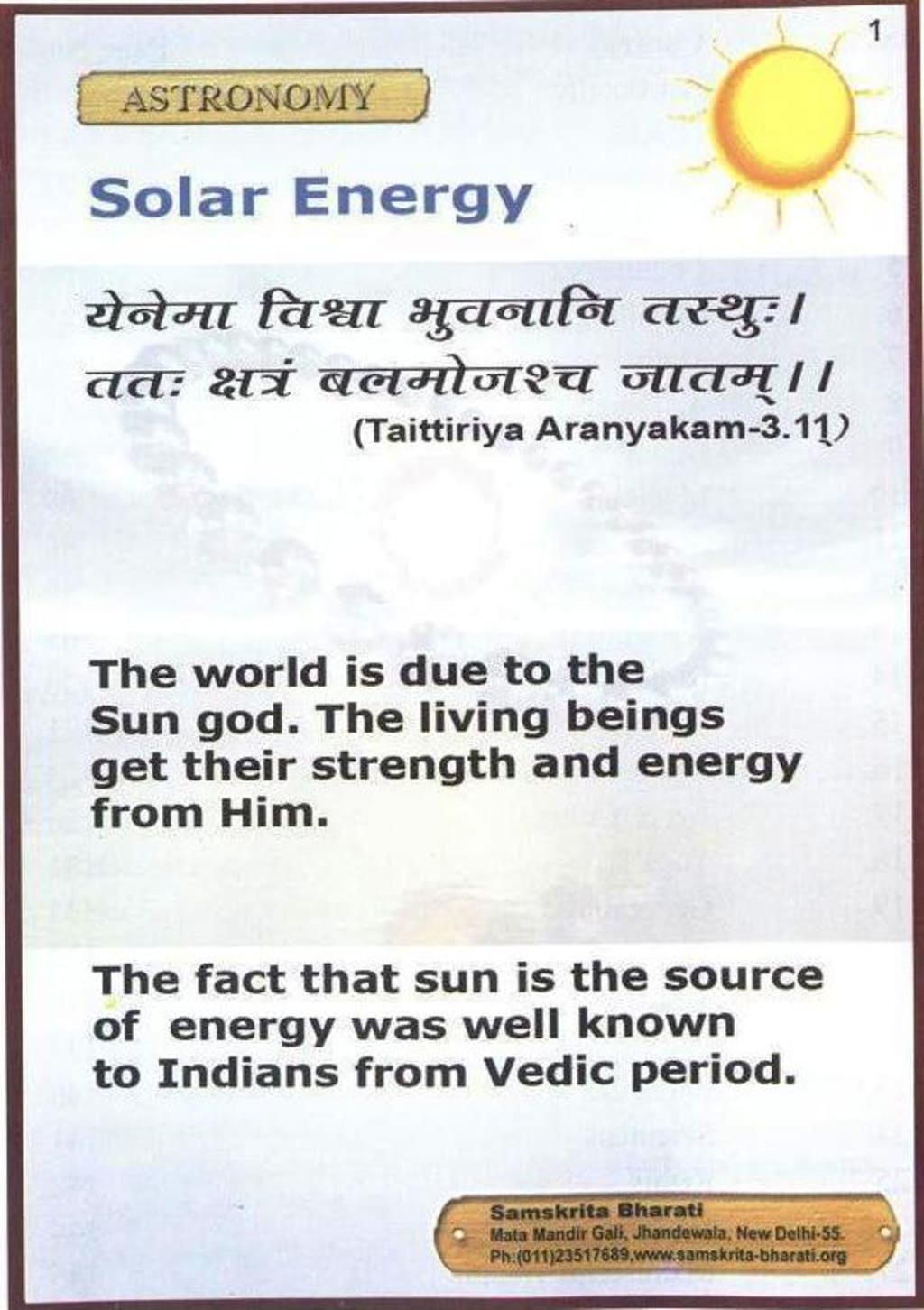Scientific Heritage Of BHARAT(INDIA).
Hare Krishna. In this blog, we will give you information on the Scientific Heritage Of BHARAT, INDIA. Hare Krishan. Hari Bol.

Ancient Wisdom: Solar Energy in Vedic Texts
The role of the sun as a source of energy is a concept that has been revered and understood for millennia. Long before modern science delved into the intricacies of solar energy, ancient Indian texts recognized the sun's vital contribution to life on Earth. This understanding is beautifully encapsulated in the Taittiriya Aranyaka (3.11), a significant scripture from the Vedic period, which states: "The world is due to the Sun god. The living beings get their strength and energy from Him."
This verse not only highlights the sun's importance but also reflects a profound appreciation for natural phenomena, which was an integral part of Vedic thought. Let's explore the multifaceted significance of solar energy in the Vedic period and its relevance in contemporary times.
The Sun in Vedic Literature
The Vedas, composed over 3,000 years ago, are the oldest sacred texts of India. They encompass a wide array of knowledge, including hymns, philosophy, rituals, and observations about nature. The sun, or Surya, holds a central place in these texts, symbolizing not just a celestial body but a divine entity that sustains life and maintains cosmic order.
In the Rigveda, one of the four primary Vedas, Surya is lauded for dispelling darkness and ignorance. The Gayatri Mantra, one of the most revered hymns, is a prayer dedicated to the sun, invoking its light and energy to illuminate our minds. This reverence underscores the ancient recognition of the sun as the ultimate source of life and energy.
Solar Energy and Its Scientific Basis
Modern science confirms what the Vedic sages intuitively knew. The sun is the primary source of energy for Earth, driving weather patterns, ocean currents, and the growth of plants through photosynthesis. This process is fundamental to the food chain, as plants convert solar energy into chemical energy, which is then passed on to herbivores and carnivores.
Photosynthesis is a marvel of nature, where plants use sunlight to convert carbon dioxide and water into glucose and oxygen. This simple yet profound process forms the backbone of life on Earth, highlighting the sun's indispensable role in sustaining ecosystems.
Solar Energy in Vedic Practices
The Vedic people not only acknowledged the sun's importance but also incorporated solar energy into their daily lives and rituals. Surya Namaskar, or Sun Salutation, is a series of yoga postures performed at sunrise, designed to harness the sun's energy. This practice not only promotes physical well-being but also aligns the practitioner with the sun's rhythm, fostering a deep connection with nature.
Furthermore, many Vedic rituals were conducted at dawn or dusk, the times when the sun's rays are most beneficial. Agnihotra, a fire ritual, involves offerings to the fire at sunrise and sunset, believed to purify the environment and enhance the well-being of participants. These practices reflect a sophisticated understanding of the sun's influence on human health and the environment.
The Relevance of Vedic Solar Wisdom Today
As we face the challenges of climate change and energy sustainability, the ancient wisdom of harnessing solar energy is more relevant than ever. The sun provides a limitless and clean source of power, which, if utilized effectively, can significantly reduce our dependence on fossil fuels and mitigate environmental degradation.
Solar power technology has advanced rapidly, making it increasingly feasible to harness the sun's energy for electricity, heating, and other applications. Solar panels, photovoltaic cells, and solar thermal systems are becoming common in homes, businesses, and public infrastructure. These technologies echo the ancient Vedic principle of living in harmony with nature and utilizing its resources wisely.
Integrating Vedic Insights with Modern Science
The integration of Vedic insights with modern science offers a holistic approach to sustainability. By combining ancient practices like Surya Namaskar and Agnihotra with contemporary solar technologies, we can create a sustainable lifestyle that honors both tradition and innovation.
Educational initiatives can play a crucial role in this integration. By incorporating the study of Vedic texts and solar energy science into curricula, we can inspire future generations to appreciate and harness the sun's power responsibly. Community programs can promote solar energy adoption and educate people about its benefits, drawing parallels to ancient wisdom.
Conclusion
The recognition of the sun as a source of energy is a timeless truth, spanning from the Vedic period to the present day. The ancient Indian texts not only celebrated the sun's life-giving force but also laid the groundwork for practices that align human life with natural rhythms. As we navigate the complexities of modern life and environmental challenges, embracing this ancient wisdom can guide us towards a sustainable future.
By integrating Vedic principles with cutting-edge solar technology, we can create a world that respects and harnesses the sun's boundless energy, ensuring the well-being of all living beings. The ancient sages' profound understanding of the sun's role in sustaining life continues to illuminate our path, reminding us of our enduring connection to the cosmos.
This is the First part(1), the next part will come soon.
MIRABANTA SAPAM.
HARE KRISHNA. HARI BOL.
About the Creator
Enjoyed the story? Support the Creator.
Subscribe for free to receive all their stories in your feed. You could also pledge your support or give them a one-off tip, letting them know you appreciate their work.





Comments
There are no comments for this story
Be the first to respond and start the conversation.